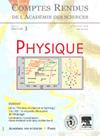纳米颗粒力学性能的建模:综述
IF 1.2
4区 物理与天体物理
Q3 ASTRONOMY & ASTROPHYSICS
引用次数: 18
摘要
纳米颗粒通常用于电子、催化或工程等各种应用领域,在这些领域中,纳米颗粒会受到一定的应力,导致结构不稳定或不可逆转的损伤。与块状材料相比,纳米颗粒可以承受极高的应力(在GPa范围内)和延展性,即使是原本脆性的材料也是如此。本文综述了纳米颗粒力学性能的建模,重点介绍了基本变形过程。描述了各种模拟方法,从经典的分子动力学计算(最适合用于纳米颗粒力学建模的方法)到基于位错动力学的混合方法。我们详细介绍了纳米颗粒在大量材料类别(金属、半导体、陶瓷等)中的机械行为,以及它们的变形过程。常规的晶体纳米粒子,以及更复杂的系统,如纳米孔或核壳粒子。除了对最近发表的关于该主题的作品进行详尽的审查外,还提出了挑战和未来趋势,为即将进行的调查提供坚实的基础。本文章由计算机程序翻译,如有差异,请以英文原文为准。
Modeling the mechanical properties of nanoparticles: a review
Nanoparticles are commonly used in various fields of applications such as electronics, catalysis or engineering where they can be subjected to a certain amount of stress leading to structural instabilities or irreversible damages. In contrast with bulk materials, nanoparticles can sustain extremely high stresses (in the GPa range) and ductility, even in the case of originally brittle materials. This review article focuses on the modeling of the mechanical properties of nanoparticles, with an emphasis on elementary deformation processes. Various simulation methods are described, from classical molecular dynamics calculations, the best suited method when applied to the modeling the mechanics of nanoparticles, to dislocation dynamics based hybrid methodologies. We detail the mechanical behaviour of nanoparticles for a large array of material classes (metals, semi-conductors, ceramics, etc.), as well as their deformation processes. Regular crystalline nanoparticles are addressed, as well as more complex systems such as nanoporous or core-shell particles. In addition to the exhaustive review on the recent works published on the topic, challenges and future trends are proposed, providing solid foundations for forthcoming investigations.
求助全文
通过发布文献求助,成功后即可免费获取论文全文。
去求助
来源期刊

Comptes Rendus Physique
物理-天文与天体物理
CiteScore
2.80
自引率
0.00%
发文量
13
审稿时长
17.2 weeks
期刊介绍:
The Comptes Rendus - Physique are an open acess and peer-reviewed electronic scientific journal publishing original research article. It is one of seven journals published by the Académie des sciences.
Its objective is to enable researchers to quickly share their work with the international scientific community.
The Comptes Rendus - Physique also publish journal articles, thematic issues and articles on the history of the Académie des sciences and its current scientific activity.
From 2020 onwards, the journal''s policy is based on a diamond open access model: no fees are charged to authors to publish or to readers to access articles. Thus, articles are accessible immediately, free of charge and permanently after publication.
The Comptes Rendus - Physique (8 issues per year) cover all fields of physics and astrophysics and propose dossiers. Thanks to this formula, readers of physics and astrophysics will find, in each issue, the presentation of a subject in particularly rapid development. The authors are chosen from among the most active researchers in the field and each file is coordinated by a guest editor, ensuring that the most recent and significant results are taken into account. In order to preserve the historical purpose of the Comptes Rendus, these issues also leave room for the usual notes and clarifications. The articles are written mainly in English.
 求助内容:
求助内容: 应助结果提醒方式:
应助结果提醒方式:


